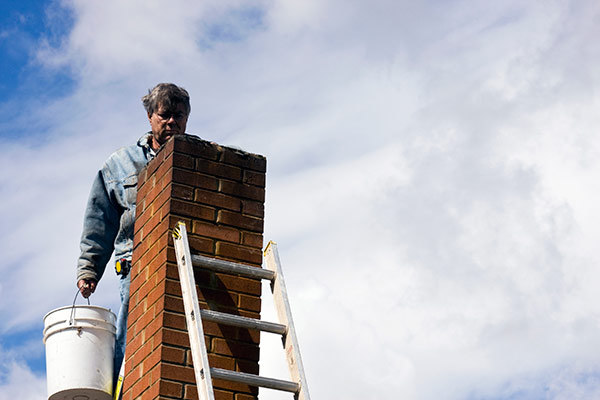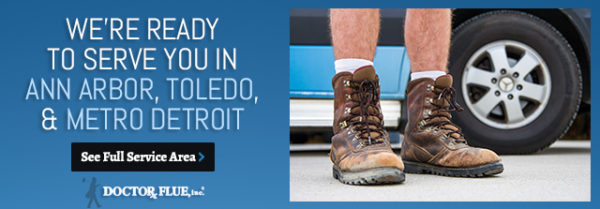
When winter rolls around here in Michigan, the weather gets unbearably frigid! Especially for those of us around Lenawee County, the last thing you want is to discover that your fireplace isn’t working correctly. Fortunately, many of the common fireplace problems are easily identified and often easily solved.
Read on to learn about the most common fireplace problems for both wood-burning and gas fireplaces and what you can do to fix them.
Creosote
Any time you use your fireplace, the smoke from combustion goes up into the chimney. The smoke, when it cools and condenses, turns into a byproduct known as creosote. This creosote is hard and resembles tar. It’s typically black or a dark brown. If you haven’t recently had a chimney cleaning, it’s also likely in your chimney!
The primary concern of creosote is that it’s a massive fire hazard. Creosote can ignite from heat, leading to damage or even chimney fires.
However, creosote also impacts your fireplace’s function, too. As creosote builds in your chimney, it restricts more and more air flow. Smoke that should exhaust from your fireplace could instead come back down into your home.
The best-case scenario is that the interrupted airflow diminishes your fire, restricting combustion and leading to even more build-up and poor fires. The worst cases, however, could be puff-backs or even carbon monoxide poisoning!
Critter Invasion
Do you hear chirping, scratching or other noises coming from your fireplace or chimney? Chances are, you have a critter that decided your chimney was its new home. Whether it’s a chimney swift or something a bit more dangerous, animals in your chimney are a serious issue!
Nesting creatures can stack obstructions on top of your chimney that make it a risk for carbon monoxide. Even if they’re not nesting, a racoon or other animal’s body alone can block your chimney from exhausting fumes.
The best way to keep your chimney critter free? A quality chimney cap. These are necessary to prevent anything from getting inside your chimney.
Obstruction
Birds and rodents aren’t the only things that can clog a chimney and stop your fireplace from functioning correctly. If you live in an area with heavy tree coverage, you’ll have leaves or falling branches land near your chimney on a regular basis. We’ve even seen garbage like plastic bags end up wrapped around chimneys!
Even with a chimney cap, random debris can get trapped around the cap. This is just as dangerous as debris falling into your chimney – and one reason why regular inspections are necessary. You can’t always get the full view of your chimney cap from ground level!
Damper Closed
Dampers are an important part of fireplaces. They help you keep heat in your home when the fireplace isn’t in use. Do you see a chain or pull-down in your fireplace? That’s how you operate it.
Whenever you have a fire in your fireplace, keep the damper open! Until the last ember completely fades away, your damper should be fully open. If not, smoke won’t have anywhere to go except back into your home. While it’s no puff-back, it could be huge mess or even put your health at risk!
Surprisingly, we’ve seen many homes where the owner thinks their fireplace’s airflow is obstructed, only to find out that they didn’t know about their damper! In some cases, the damper can be stuck due to debris or hardened soot. This will be easily identified during a standard chimney inspection – and your chimney sweep will be able to clean it easily.
Poor-Quality Firewood
If you light a fire in your fireplace and it doesn’t seem like the fire is burning properly, it could be your firewood. The best firewood is seasoned. Fresh wood will still have a lot of moisture inside, preventing complete combustion. The more inefficient the combustion, the weaker the fire.
Low-burning fires offer little in the way of heat and actually produce more smoke. You’ll find that green firewood leads to faster build-ups of creosote too!
Store your firewood and only burn seasoned wood! It’s easy to store wood properly with just a tarp and some space outside. It’s also worth mentioning – never burn anything that isn’t firewood! Burning trash or even construction wood can fill your home with chemical-laden smoke, damaging your house and your health.
Common Gas Fireplace Problems
In addition to some of the common problems that any fireplace or chimney can have, gas fireplaces sometimes have unique reasons they aren’t working quite right. However, unlike wood-burning fireplaces, it can be more difficult for a homeowner to identify and fix without the help of a professional.
Pilot Light Failure
Gas fireplaces use a pilot light just like most other gas appliances. If your fireplace refuses to turn on, the pilot light is often the culprit. Fortunately, it’s easy to check! Simply open the vent and see if you can spot a small flame. If you can’t, the pilot light needs to be lit again.
Follow the instructions to relight your pilot light carefully. You always want to be careful working with gas appliances. If you aren’t sure how to properly relight it, contact the manufacturer or give us a call!
Damaged Thermocouple or Thermopile
Another key component of your gas fireplace is the thermocouple. These special metal rods generate electricity from heat and act as a sensor to make sure gas only runs when a fire is lit.
Older thermocouples or those that may have been installed improperly can sometimes fail to function correctly. You’ll often notice this if the gas fireplace ignites correctly but shuts off. If you have to relight the pilot light, but then it goes out quickly, it’s likely the thermocouple.
Newer fireplaces often use a thermopile instead. In many ways, they operate similarly to a thermocouple. If your fireplace is a newer model and you notice these issues, check the thermopile or contact a professional to check it for you!

Get Your Fireplace Ready – Call Doctor Flue!
The warmer months are the perfect time for your annual chimney inspection! Contact us today so your fireplace or stove is ready when winter hits!
Call Us: 1-800-438-3583
Email Us: office@drflue.com
Office Hours: Mon-Fri: 8am-4pm
Connect with Doctor Flue on Social Media
